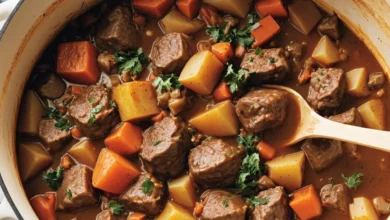Fluffy Sourdough Hamburger Bun Recipe: Elevate Your Burger Game

Homemade sourdough hamburger buns are a game-changer for any burger lover. With their slightly tangy flavor, soft texture, and sturdy structure, these buns not only enhance the taste of your burgers but also add a homemade touch to your meals. In this article, we’ll guide you through a simple and delicious sourdough hamburger bun recipe that will have your taste buds celebrating!
Why Choose Sourdough Hamburger Buns?
- Unique Flavor: The natural fermentation process of sourdough gives these buns a delightful tang that complements savory fillings perfectly.
- Health Benefits: Sourdough fermentation may make the bread easier to digest and enhance nutrient absorption.
- Customizable: You can easily adapt the recipe by adding herbs, spices, or toppings to suit your taste.
Fluffy Sourdough Hamburger Bun Recipe
Ingredients:
- 1 cup active sourdough starter (fed and bubbly)
- 1/2 cup warm water
- 1/4 cup milk (or dairy-free alternative)
- 2 tablespoons sugar (or honey)
- 1 large egg
- 3 1/2 cups all-purpose flour
- 1 teaspoon salt
- 3 tablespoons unsalted butter (softened)
- Sesame seeds (optional, for topping)
Instructions:
- Prepare the Dough: In a large mixing bowl, combine the active sourdough starter, warm water, milk, sugar, and egg. Mix until well combined.
- Incorporate Dry Ingredients: Add the all-purpose flour and salt to the wet mixture. Stir until a shaggy dough forms.
- Knead the Dough: Add the softened butter to the dough and knead on a floured surface for about 8-10 minutes, until the dough is smooth and elastic. You can also use a stand mixer with a dough hook for this step.
- First Rise: Place the kneaded dough in a greased bowl, cover it with plastic wrap or a kitchen towel, and let it rise in a warm spot for about 4-6 hours or until it has doubled in size. If you’re making the dough in the evening, you can also refrigerate it overnight for a slow rise.
- Shape the Buns: Once the dough has risen, punch it down to release the air. Divide the dough into 8 equal pieces (for regular-sized buns) or 10 pieces (for smaller buns). Shape each piece into a smooth ball and place them on a baking sheet lined with parchment paper, leaving space between each bun for expansion.
- Second Rise: Cover the shaped buns with a towel and let them rise for another 1-2 hours, or until they’ve puffed up.
- Preheat Oven: About 20 minutes before baking, preheat your oven to 375°F (190°C).
- Egg Wash: If desired, whisk together an egg with a splash of water and brush the mixture over the tops of the buns. This will give them a nice golden color. Sprinkle sesame seeds on top if you like.
- Bake: Bake the buns in the preheated oven for 20-25 minutes, or until they are golden brown and sound hollow when tapped on the bottom.
- Cool: Remove the buns from the oven and let them cool on a wire rack. Allow them to cool completely before slicing.
Frequently Asked Questions About Sourdough Hamburger Buns
1. Can I use a different type of flour?
Yes, you can use bread flour for a chewier texture or whole wheat flour for a healthier option, but you may need to adjust the liquid content slightly.
2. How should I store leftover buns?
Store the cooled buns in an airtight container at room temperature for up to 3 days. You can also freeze them for up to 3 months. Just wrap them tightly in plastic wrap and place them in a freezer bag.
3. Can I make these buns without a sourdough starter?
While this recipe is designed for sourdough, you can substitute with instant yeast (about 2 teaspoons) if you don’t have a starter. Adjust the liquid accordingly.
4. How can I customize my buns?
Feel free to add herbs, spices, or even cheese to the dough for added flavor. Garlic powder, onion powder, or chopped fresh herbs work wonderfully!
5. Can I make mini burger buns?
Absolutely! Simply divide the dough into smaller portions (about 10-12 pieces) and follow the same process for shaping and rising.
Conclusion
This fluffy sourdough hamburger bun recipe is a fantastic way to elevate your burger experience. The unique flavor and soft texture of these homemade buns will impress your family and friends and keep them coming back for more. Whether you’re grilling burgers for a summer cookout or enjoying a cozy dinner at home, these sourdough buns will be the perfect complement. Try this recipe today and savor the delightful taste of homemade sourdough!





